Grace Elliot's Blog: 'Familiar Felines.' , page 40
November 7, 2010
'Familiar Felines' - cats and witchcraft.
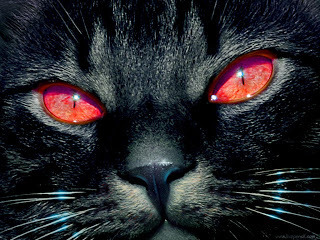 A Norse legend, tells that Freya, the goddess of love and fertility, rode in a chariot pulled by two black cats. The latter were actually her swift horses that had been possessed by the devil. The cats served Freya well for seven years, and at the end of this time were rewarded by being turned into witches – disguised as cats!
A Norse legend, tells that Freya, the goddess of love and fertility, rode in a chariot pulled by two black cats. The latter were actually her swift horses that had been possessed by the devil. The cats served Freya well for seven years, and at the end of this time were rewarded by being turned into witches – disguised as cats!
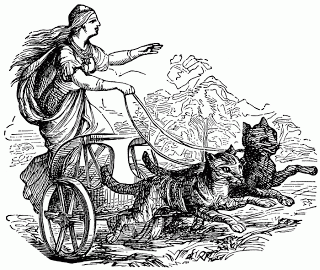
Centuries old insecurities led the cat to be labelled as the witch's familiar. The Hungarians even specified that this happened at seven years of age – the cat could be spared this fate by incising a crucifix into its skin before it reached this significant age.
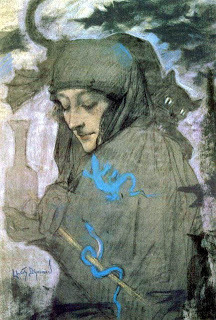
So great was the association of cats with witchcraft in 15th century Europe that they became synonymous as a symbol of evil. Scotland had its own sinister cat, the Cait Sith or Highland Fairy Cat. More a demon than a fairy, this monstrous black and white animal with a spot on his chest, was said to be a transformed witch.
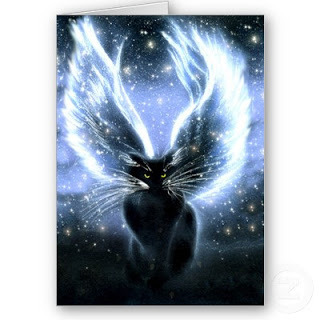
Pope Innocent VIII legalised the persecution of witches, and as a result many women who kept cats were tortured. The hysteria spread, encouraged in the name of 'casting out the devil.' When Queen Elizabeth I came to the throne, some protestants staged a mocking ceremony of this superstition, by filling a wicker dummy of the Pope with cats, which they threw onto a bonfire. The screams of the cats was said to be,'The language of the devil from the body of the Holy Father.'This sick cycle continued with Catholics shaving the heads of cats, to represent protestant friars, before hanging the poor animals.
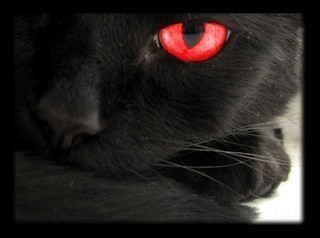 Next week - More Cat-tales from history.
Next week - More Cat-tales from history.
Published on November 07, 2010 08:48
November 4, 2010
'Cock a Hoop'
From passing a driving test to getting engaged, we've all been 'cock a hoop' at one time or another. But did you realise the original meaning of this phrase was 'to drink alcohol without restraint'?
To learn more about the history of this saying follow the link:
http://graceelliot-author.blogspot.co...
A Dead Man's Debt
To learn more about the history of this saying follow the link:
http://graceelliot-author.blogspot.co...
A Dead Man's Debt
Published on November 04, 2010 07:03
•
Tags:
a-dead-man-s-debt, grace-elliot, historical-romance, romance
November 1, 2010
October 31, 2010
Cats and the Possessed.
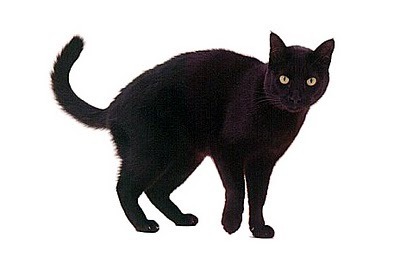 On Halloween, spirits from the underworld are said to roam the earth. This tradition has it roots in the
On Halloween, spirits from the underworld are said to roam the earth. This tradition has it roots in thepagan festival of Samhain. This marked the start of winter when a portal between the spiritual and physical
worlds briefly opened. The Anglo Saxons held a similar the festival on the same date 'Halloween', before
the Catholic Church christianised October 31st, as the eve of All Saints Day.

However, folklore in many countries has it that the devil can enter man's domain throughout the year, using the cat as his agent. Old English custom held that a cat roving a graveyard was looking for a soul to possess and a cat sitting on a tombstone meant the deceased now belonged to the devil. Two cats fighting in a cemetery were the devil and an angel fighting over a soul of the dead. Throughout medieval Europe, pagan black mass often involved a black cat, to represent the devil, and a white cat, a healer.
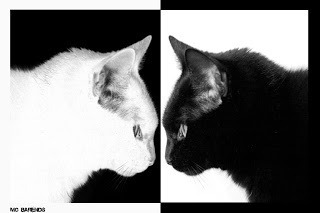
Remarkably similar superstitions existed in ancient China. On the death of his owner, a cat would be given away until after the burial. The relatives believed that if the cat leapt over the body, the corpse would rise up and miss its chance of redemption. In parts of Eastern Europe, a cat jumping over a corpse was said to transform the deceased into a vampire and in Northumbria during the middle ages, a cat that walked over a body would be killed, so that it couldn't steal the soul of the departed human.
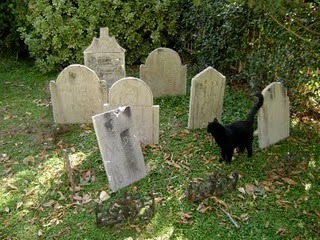
On a more positive note, the Malayan Jakurs believed that when they died, a cat would be ready and waiting to lead them through the fires of hell to heaven, spraying as he went to cool the pathway. Likewise the Egyptian Pharaoh, Tutankhamen, was led to the underworld by a black cat.
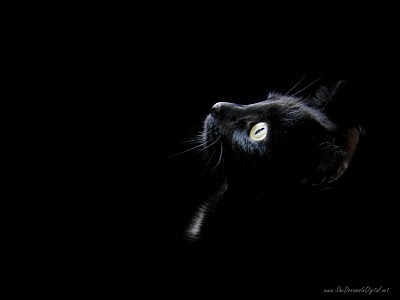
Published on October 31, 2010 09:21
October 24, 2010
'Shackleton Shot my Cat!'
Today's post looks at a touching story of devotion and survival - a man and his cat "Mrs Chippy."
 Shackleton's ship 'Endurance' trapped in ice.
Shackleton's ship 'Endurance' trapped in ice.
In 1914 adventurer and explorer, Earnest Shackleton assembled a crew of like minded men to voygage to the Antartic in the Endurance. Master shipwright, the carpenter Henry McNeish, smuggled a cat aboard in his tool box. Much to the crews amusement this cat followed the carpenter around like 'a suspicious wife checking up on her husband' and despite actually being a tom cat, earnt the name "Mrs Chippy."
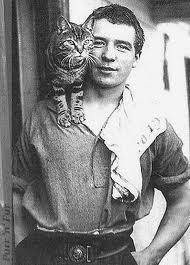 Mrs Chippy (acutally a tom cat!) on the shoulder of a crew member.
Mrs Chippy (acutally a tom cat!) on the shoulder of a crew member.
Aboard ship Mrs Chippy had many adventures of his own. The diary of Thomas Orde-Lees recounts the night of 13th September 1914 when Mrs Chippy fell overboard out of a porthole. Luckily the Officer of the Watch heard the spalsh and was able to turn the Endurance around, and despite spending 10 minutes in freezing water the cat was rescued, fit and well.
Mrs Chippy was not above tormenting the 60 Canadian Husky sled dogs, kenneled on the upper decks - either by sitting for a wash just out of reach, or by sharpening his claws on their kennels. The Bo-sun was so enraged by this activity that he threatened to toss the cat overboard - and was demoted for his efforts!
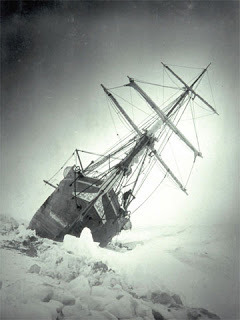 Endurance - trapped in ice for 6 months then abandoned.
Endurance - trapped in ice for 6 months then abandoned.
But then disaster struck the expedition. In January 1915 the Endurance became trapped in Antarctic ice sheets. Worse still, Mrs Chippy disappeared for 5 whole days and many feared he had frozen to death - only to reemerge stretching and yawning as if he'd just woken from a good sleep!
'Mrs Chippy 's almost total disregard for the diabolical forces at work on the ship was more than remarkable - it was inspirational.' [A crew member]
Whilst the Endurance's crew eeked out their rations by eating penguin and seal meat, Mrs Chippy refused to compromise and insisted on his preferred diet of tinned sardines. In the 6 months the crew was stranded, Mrs Chippy was the only one to gain weight!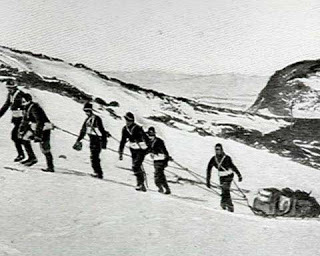 But after 6 months the huge crushing force of the ice took its toil on Endurance and there was no option but for the men to abandon their ship and make a heroic hike across ice sheets to find help. In this desperate survival situation Shackleton has little choice but to insist only items essential to survival were taken - and this did not include Mrs Chippy. After a final meal of sardines Mrs Chippy curled up for a sleep ...and never woke up. Shackleton ordered the cat shot.
But after 6 months the huge crushing force of the ice took its toil on Endurance and there was no option but for the men to abandon their ship and make a heroic hike across ice sheets to find help. In this desperate survival situation Shackleton has little choice but to insist only items essential to survival were taken - and this did not include Mrs Chippy. After a final meal of sardines Mrs Chippy curled up for a sleep ...and never woke up. Shackleton ordered the cat shot.
Despite the amazing feet of all crew members reaching safety under Shackleton's leadership, a decade later Henry Mc Neish was still bitter about the loss of his cat. When interviewed about his ordeal, all he would comment was, 'Shackleton shot my cat.'
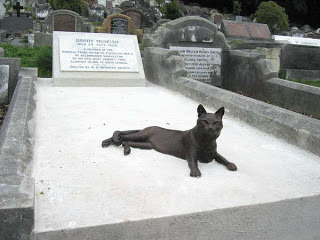 A bronze statue of Mrs Chippy resting on his master's grave.
A bronze statue of Mrs Chippy resting on his master's grave.
Happily in 2004, the New Zealand Antarctic Society rectified their separation and commissioned a statue of Mrs Chippy to rest on Henry Nc Neish's grave.-
 Shackleton's ship 'Endurance' trapped in ice.
Shackleton's ship 'Endurance' trapped in ice.In 1914 adventurer and explorer, Earnest Shackleton assembled a crew of like minded men to voygage to the Antartic in the Endurance. Master shipwright, the carpenter Henry McNeish, smuggled a cat aboard in his tool box. Much to the crews amusement this cat followed the carpenter around like 'a suspicious wife checking up on her husband' and despite actually being a tom cat, earnt the name "Mrs Chippy."
 Mrs Chippy (acutally a tom cat!) on the shoulder of a crew member.
Mrs Chippy (acutally a tom cat!) on the shoulder of a crew member.Aboard ship Mrs Chippy had many adventures of his own. The diary of Thomas Orde-Lees recounts the night of 13th September 1914 when Mrs Chippy fell overboard out of a porthole. Luckily the Officer of the Watch heard the spalsh and was able to turn the Endurance around, and despite spending 10 minutes in freezing water the cat was rescued, fit and well.
Mrs Chippy was not above tormenting the 60 Canadian Husky sled dogs, kenneled on the upper decks - either by sitting for a wash just out of reach, or by sharpening his claws on their kennels. The Bo-sun was so enraged by this activity that he threatened to toss the cat overboard - and was demoted for his efforts!
 Endurance - trapped in ice for 6 months then abandoned.
Endurance - trapped in ice for 6 months then abandoned.But then disaster struck the expedition. In January 1915 the Endurance became trapped in Antarctic ice sheets. Worse still, Mrs Chippy disappeared for 5 whole days and many feared he had frozen to death - only to reemerge stretching and yawning as if he'd just woken from a good sleep!
'Mrs Chippy 's almost total disregard for the diabolical forces at work on the ship was more than remarkable - it was inspirational.' [A crew member]
Whilst the Endurance's crew eeked out their rations by eating penguin and seal meat, Mrs Chippy refused to compromise and insisted on his preferred diet of tinned sardines. In the 6 months the crew was stranded, Mrs Chippy was the only one to gain weight!
 But after 6 months the huge crushing force of the ice took its toil on Endurance and there was no option but for the men to abandon their ship and make a heroic hike across ice sheets to find help. In this desperate survival situation Shackleton has little choice but to insist only items essential to survival were taken - and this did not include Mrs Chippy. After a final meal of sardines Mrs Chippy curled up for a sleep ...and never woke up. Shackleton ordered the cat shot.
But after 6 months the huge crushing force of the ice took its toil on Endurance and there was no option but for the men to abandon their ship and make a heroic hike across ice sheets to find help. In this desperate survival situation Shackleton has little choice but to insist only items essential to survival were taken - and this did not include Mrs Chippy. After a final meal of sardines Mrs Chippy curled up for a sleep ...and never woke up. Shackleton ordered the cat shot. Despite the amazing feet of all crew members reaching safety under Shackleton's leadership, a decade later Henry Mc Neish was still bitter about the loss of his cat. When interviewed about his ordeal, all he would comment was, 'Shackleton shot my cat.'
 A bronze statue of Mrs Chippy resting on his master's grave.
A bronze statue of Mrs Chippy resting on his master's grave.Happily in 2004, the New Zealand Antarctic Society rectified their separation and commissioned a statue of Mrs Chippy to rest on Henry Nc Neish's grave.-
Published on October 24, 2010 07:32
October 17, 2010
Cat Armour.
Today's blog post looks at the stunning work of artist, Jeff de Boer.
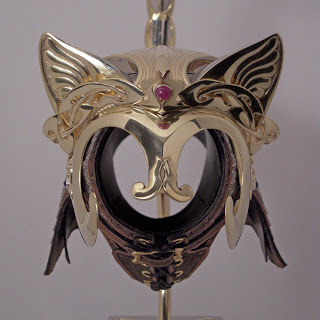 'Elven Princess' helmet - nickel, brass, leather and jade.
'Elven Princess' helmet - nickel, brass, leather and jade.
Jeff is a Calgary based artist whose career orginated in making suits of armour for people. Later, when studying at the Alberta College of Art and Design, he married his two interests in a sculpture project - by making a suit of cat armour.
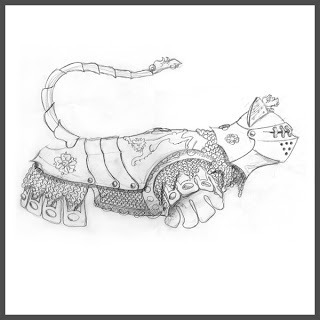
The artist first draws the suit he has visualised. Then using sheet metal and jewellry makers tools he slowly bring the sketch to life, starting with the helmet and working backwards so every piece is in proportion.
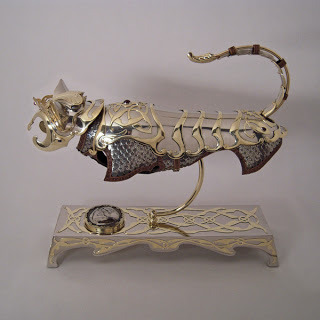 Elven Princess Armour.
Elven Princess Armour.
Materials used to create one of these materpieces include; aluminium, brass, copper, nickel, silver, aluminium, jewels such as jade and textiles like leather.
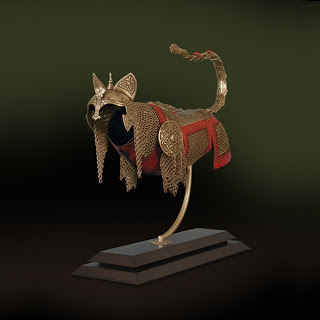 Persian Cat Armour.A suit of armour for a cat takes between 50 to 200 hours to make.
Persian Cat Armour.A suit of armour for a cat takes between 50 to 200 hours to make.
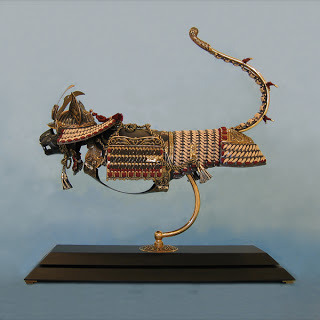 Samuria Siamese Armour.Not content with the challenge of cat armour, Jeff also designs armour for mice - hence restoring some balance to the universe.
Samuria Siamese Armour.Not content with the challenge of cat armour, Jeff also designs armour for mice - hence restoring some balance to the universe.
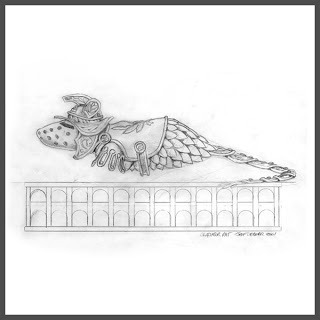
Sketch for Gladiator Mouse Armour.
To make a suit of silver mouse armour takes around 20 hours, and to polish it 10 hours.
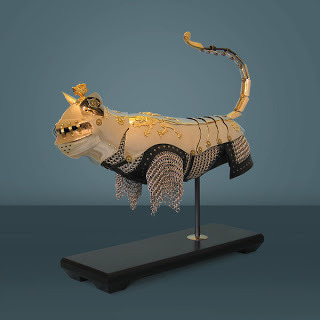 Tournament Cat Armour.
Tournament Cat Armour.
I'm sure you will all agree that Jeff's work is utterly stunning both in execution and idea. Many thanks for Jeff de Boer and more of his work can be viewed at his website:
http://www.jeffdeboer.com/
 'Elven Princess' helmet - nickel, brass, leather and jade.
'Elven Princess' helmet - nickel, brass, leather and jade.Jeff is a Calgary based artist whose career orginated in making suits of armour for people. Later, when studying at the Alberta College of Art and Design, he married his two interests in a sculpture project - by making a suit of cat armour.

The artist first draws the suit he has visualised. Then using sheet metal and jewellry makers tools he slowly bring the sketch to life, starting with the helmet and working backwards so every piece is in proportion.
 Elven Princess Armour.
Elven Princess Armour. Materials used to create one of these materpieces include; aluminium, brass, copper, nickel, silver, aluminium, jewels such as jade and textiles like leather.
 Persian Cat Armour.A suit of armour for a cat takes between 50 to 200 hours to make.
Persian Cat Armour.A suit of armour for a cat takes between 50 to 200 hours to make.  Samuria Siamese Armour.Not content with the challenge of cat armour, Jeff also designs armour for mice - hence restoring some balance to the universe.
Samuria Siamese Armour.Not content with the challenge of cat armour, Jeff also designs armour for mice - hence restoring some balance to the universe. 
Sketch for Gladiator Mouse Armour.
To make a suit of silver mouse armour takes around 20 hours, and to polish it 10 hours.
 Tournament Cat Armour.
Tournament Cat Armour. I'm sure you will all agree that Jeff's work is utterly stunning both in execution and idea. Many thanks for Jeff de Boer and more of his work can be viewed at his website:
http://www.jeffdeboer.com/
Published on October 17, 2010 05:48
October 9, 2010
Are you an Ailurophobe?
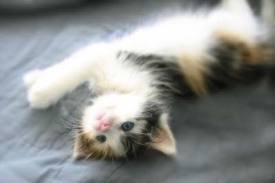 I'm not an ailurophobe. Quite the opposite in fact.
I'm not an ailurophobe. Quite the opposite in fact.How about you?
An ailurophobe is a person with 'an irrational fear or hatred of cats.'
The term was first used by the Greek historian, Heroditus, after describing all the cats he saw in Egypt as 'tail wavers' or 'ailuroi.'
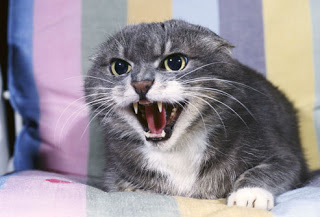 William Shakespeare was evidently an ailurophobe.
William Shakespeare was evidently an ailurophobe.'I can endure anything but a cat, the only good cat is a dead cat.'
But Shakespeare's dislike of cats was but as nothing compared to Napoleon Bonaparte's fierce fear of felines.
The French Emperor's Fear.At the Battle of Wagram, an Aide de Campe heard cries for help coming from Bonaparte's tent. Fearing for his leader was in mortal danger, the Aide drew his sword and entered to find Napoleon sweating profusely and stabbing the air because a stray cat had wandered in. Evidently this fear was no secret. On another occaision a political opponent wrong footed Napoleon in an important debate merely by mentionning a cat!
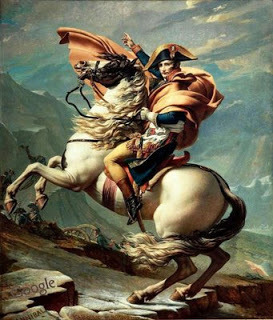 Napoleon Bonaparte, French Emperor - was afraid of cats. My favourite Napoleon story comes from after his defeat at the Battle of Waterloo. Exiled by the British to the island of Saint Helena, Napoleon's residence was the damp, vermin infested estate at Longwood. 'Rats...came out at night...so thick as the floor appeared black.'
Napoleon Bonaparte, French Emperor - was afraid of cats. My favourite Napoleon story comes from after his defeat at the Battle of Waterloo. Exiled by the British to the island of Saint Helena, Napoleon's residence was the damp, vermin infested estate at Longwood. 'Rats...came out at night...so thick as the floor appeared black.'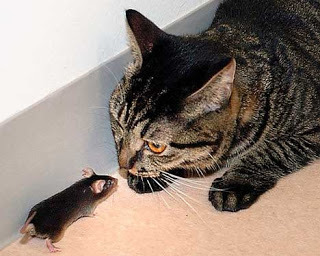 Reports filtered back to England that the Emporer had been biten by a rat. Ever compassionate, and perhaps knowing of his fear, it was decided to send a ship load of cats to St Helena. Posters were put up in market places offering sixpence per cat; strays and farm cats were rounded up by the wagon load, and promplty despatched to help with the infestaton. One can only imagine Napoleon's reaction when this cargo arrived at St Helena.
Reports filtered back to England that the Emporer had been biten by a rat. Ever compassionate, and perhaps knowing of his fear, it was decided to send a ship load of cats to St Helena. Posters were put up in market places offering sixpence per cat; strays and farm cats were rounded up by the wagon load, and promplty despatched to help with the infestaton. One can only imagine Napoleon's reaction when this cargo arrived at St Helena. Sir Walter Scott - a reformed ailurophobe.18th century historical novelist and poet, Sir Walter Scott, came to like cats in later life. 'The greatest advantage of old age I have yet found is liking a cat, an animal which I previously detested.'He wrote further:'I suspect many an ailurophobe hates cats only because he feels they are better than he is - more honest, more secure, more loved, more whatever he is not.'
I cant argue with that!
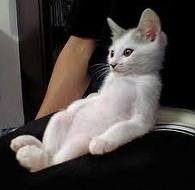 Surely no one could be afraid of such an adorable creature?
Surely no one could be afraid of such an adorable creature?
Published on October 09, 2010 13:36
October 5, 2010
Grace Elliot - blog.: HISTORICAL SLANG.
Grace Elliot - blog.: HISTORICAL SLANG.: "5th October 2010. 'DAYLIGHT ROBBERY.' Surpisingly, the origin of the term 'Daylight Robbery' isnt as obvious as you might suppose. 'Dayli..."
Published on October 05, 2010 03:15
September 25, 2010
'Trixie' in the Tower of London.
You may have realised by now that I'm a bit of a cat addict. In today's blog I have combined my favourite things - cats and history - with the true story of Trixie and the Third Earl of Southampton in the Tower of London.
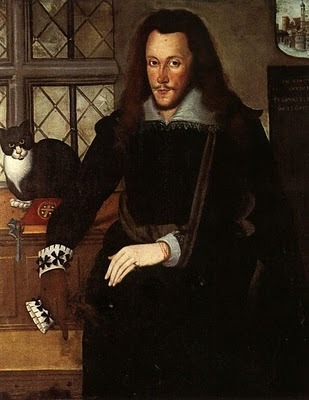 Henry Wriothesley, the Third Earl of Southampton, and his cat Trixie. (Tower of London. n the top RIGHT corner)
Henry Wriothesley, the Third Earl of Southampton, and his cat Trixie. (Tower of London. n the top RIGHT corner)
This portrait shows the long faced Earl with his beloved cat, Trixie, and over his left shoulder a picture of the Tower of London. A somewhat unusual portrait the true story behind it is fascinating.
 Boughton Hall - the 'English Versailles.'Henry was at court in the time of the ageing Queen Elizabeth I. In fact his ancestoral home, Boughton Hall (described as the English Versaille) houses he only portrait of Elizabeth I looking old.
Boughton Hall - the 'English Versailles.'Henry was at court in the time of the ageing Queen Elizabeth I. In fact his ancestoral home, Boughton Hall (described as the English Versaille) houses he only portrait of Elizabeth I looking old.
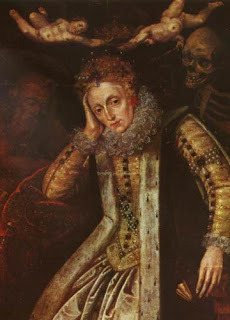 Allegorical portrait of Queen Elizabeth I - she hated to be seen looking old.Unfortunately Henry was close friends with Robert Devereux, Master of the Horse and one of the Queen's favourites. However the royal attention went to Devereux's head and he became cocky, disobeying the Queen's direct orders and squandering her money. The furious Elizabeth withdrew royal patronage and with Devereux facing financial ruin he masterminded a rebellion. Rightly or wrongly Henry was named as a conspirator, arrested for treason and sent to the Tower of London to await execution.
Allegorical portrait of Queen Elizabeth I - she hated to be seen looking old.Unfortunately Henry was close friends with Robert Devereux, Master of the Horse and one of the Queen's favourites. However the royal attention went to Devereux's head and he became cocky, disobeying the Queen's direct orders and squandering her money. The furious Elizabeth withdrew royal patronage and with Devereux facing financial ruin he masterminded a rebellion. Rightly or wrongly Henry was named as a conspirator, arrested for treason and sent to the Tower of London to await execution.
 The Tower of London.
The Tower of London.
But Wriothesley's devoted black-and-white cat, Trixie, saw him dragged from the house and followed along the London streets. Taken to the Tower, the story has it that Trixie jumped onto the roof tops and popped down an unlit chimney into his cell. Goodness only knows what a comfort she was to him, sharing his incarceration at such a terrible time, thinking he might die any day.
Happily the story ends well. Wriothesley remained in prison until Elizabeth died in 1603. The new monarch, King James I of England, pardonned him and eventually made Henry Wriothesley a Knight of the Garter. To mark this momentous event, Henry did what any decent cat lover would do - commission a portrait of him with faithful feline friend Trixie.
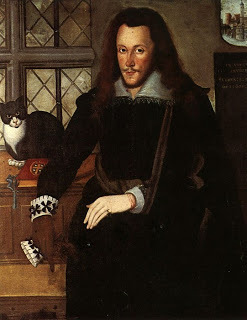
-oO0Oo-
 Henry Wriothesley, the Third Earl of Southampton, and his cat Trixie. (Tower of London. n the top RIGHT corner)
Henry Wriothesley, the Third Earl of Southampton, and his cat Trixie. (Tower of London. n the top RIGHT corner)This portrait shows the long faced Earl with his beloved cat, Trixie, and over his left shoulder a picture of the Tower of London. A somewhat unusual portrait the true story behind it is fascinating.
 Boughton Hall - the 'English Versailles.'Henry was at court in the time of the ageing Queen Elizabeth I. In fact his ancestoral home, Boughton Hall (described as the English Versaille) houses he only portrait of Elizabeth I looking old.
Boughton Hall - the 'English Versailles.'Henry was at court in the time of the ageing Queen Elizabeth I. In fact his ancestoral home, Boughton Hall (described as the English Versaille) houses he only portrait of Elizabeth I looking old.  Allegorical portrait of Queen Elizabeth I - she hated to be seen looking old.Unfortunately Henry was close friends with Robert Devereux, Master of the Horse and one of the Queen's favourites. However the royal attention went to Devereux's head and he became cocky, disobeying the Queen's direct orders and squandering her money. The furious Elizabeth withdrew royal patronage and with Devereux facing financial ruin he masterminded a rebellion. Rightly or wrongly Henry was named as a conspirator, arrested for treason and sent to the Tower of London to await execution.
Allegorical portrait of Queen Elizabeth I - she hated to be seen looking old.Unfortunately Henry was close friends with Robert Devereux, Master of the Horse and one of the Queen's favourites. However the royal attention went to Devereux's head and he became cocky, disobeying the Queen's direct orders and squandering her money. The furious Elizabeth withdrew royal patronage and with Devereux facing financial ruin he masterminded a rebellion. Rightly or wrongly Henry was named as a conspirator, arrested for treason and sent to the Tower of London to await execution. The Tower of London.
The Tower of London.But Wriothesley's devoted black-and-white cat, Trixie, saw him dragged from the house and followed along the London streets. Taken to the Tower, the story has it that Trixie jumped onto the roof tops and popped down an unlit chimney into his cell. Goodness only knows what a comfort she was to him, sharing his incarceration at such a terrible time, thinking he might die any day.
Happily the story ends well. Wriothesley remained in prison until Elizabeth died in 1603. The new monarch, King James I of England, pardonned him and eventually made Henry Wriothesley a Knight of the Garter. To mark this momentous event, Henry did what any decent cat lover would do - commission a portrait of him with faithful feline friend Trixie.

-oO0Oo-
Published on September 25, 2010 03:44
September 19, 2010
Pet Memorials....and Post Impressionism.

Following my previous posting, 'Raining Cats and Dogs' a solution was badly needed about what to do with the bodies of deceased pet animals. The problem was so bad in 19th century Paris that the river Seine was constantly polluted with bodies swept from the city streets into her waters.
 The River Seine in modern times.
The River Seine in modern times. A Pet Cemetery is Proposed.
In the 1830's veterinarian Monsieur Changeur proposed the idea of a pet cemetery. He wrote sentimentally:
'...to secure a patch of land for the animal who was a faithful companion, a consoler of pain, who often has to is credit the rescue of human life...'
His plan had practical merits:
'...to improve the sanitation of Paris where in spite of the rules and regulations, dead animals are often buried in conditions that are detrimental to human health. Let us put an end to the waters of the Seine being poisoned by dead animals thrown into it...'
French Post Impressionism and Asnieres.
Several decades later Monsieur Changeur's campaign bore fruit several and a site purchased for the pet cemetery. The plot of land was near the Siene, at Asnieres, immortalised in Georges Seurat painting 'The Bathers at Asnieres.'
 French post-impressionist painter, Georges Seurat and 'Une Baignade a Asnieres.'50 francs for a private plot.
French post-impressionist painter, Georges Seurat and 'Une Baignade a Asnieres.'50 francs for a private plot.The cemetery opened in 1899...for a fee. It cost 5 francs to bury an animal in common ground and 50 francs for of a private plot for 10 years (no mention what happens at the end of the ten years!) Alternatively, for those that could afford, 100 francs would obtain an exclusive plot for one hundred years.
However, there were strict restrictions about monuments and memorials considered appropriate for animals.
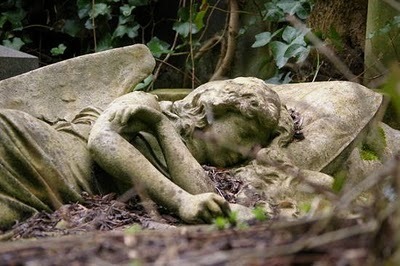 Monuments were banned from being reminiscent of human memorials. Restrictions on Memorials and Monuments.
Monuments were banned from being reminiscent of human memorials. Restrictions on Memorials and Monuments.Strict rules aimed to keep a definate distinction between human and animal burials. It was strictly forbidden to have:
'Ceremonies and decorations that mimic human burial.'
But that didnt stop many moving epitaphs from being inscribed on the tombstones. Such as:
'The more I know people, the more I love my dog.'
'One would have thought he was human...only he was faithful.'
'Decieved by the world but never by my dog.'
To finish, on a lighter note, I rather like the english humour from this memorial by Mr Kennedy, to his dog 'Scruffy.'
'Near this place lie the remains of a the faithful terrier, Scruffy.
Sever incontinence cut short a long life at the age of 18 years,
If her bladder had been stronger she would have lasted even longer.'

Published on September 19, 2010 08:07
'Familiar Felines.'
Following on from last weeks Halloween posting, today's blog post looks at the unwanted image of cats as the witches familiar - from the Norse Goddess Freya to lonely women in the middle ages.
The full Following on from last weeks Halloween posting, today's blog post looks at the unwanted image of cats as the witches familiar - from the Norse Goddess Freya to lonely women in the middle ages.
The full post can found at:
http://graceelliot-author.blogspot.com
...more
The full Following on from last weeks Halloween posting, today's blog post looks at the unwanted image of cats as the witches familiar - from the Norse Goddess Freya to lonely women in the middle ages.
The full post can found at:
http://graceelliot-author.blogspot.com
...more
- Grace Elliot's profile
- 156 followers



